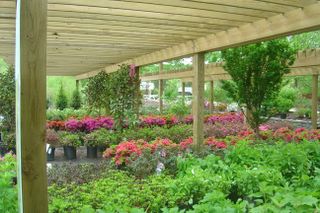THE OLD SIGN PHILOSOPHER, THOUGHT FOR THE DAY!
WE DON'T INHERIT THE EARTH FROM OUR PARENTS. WE ONLY BURROW IT FROM OUR CHILDREN.
XXXXXXXXXXXXXXXXXXXXXXXXXXXXXXXXXXXXXXXXXXXXXXXXXXX
The past few days we have been swamped with questions about newly planted trees and shrubs not looking well. The problem with the majority of the inquiries is lack of water. The next thing most people say is "We've just had alot of rainfall". How quickly everyone forgets that we had a whooping 1/2 inch of rainfall for the month of May. The period of time that normally has four inches. I hate to be a bearer of bad news but "
DURING DROUGHTS YOU MUST WATER PLANTS". And the worst watering tool is "IRRIGATION SYSTEMS". The sprinkler system is for your lawn not TREES AND SHRUBBERY. Newly planted trees require of minimum of five gallons of water weekly. Most shrubbery require 2 gallons of water weekly.
Watering requirements: Hand water newly planted nursery stock..... take a five gallon bucket out and time how long it takes to fill the bucket and then pull the hose around your yard and water accordingly. If it takes 30 seconds to fill the bucket....water each tree 30 seconds and the corresponding time to a shrub.
At the garden center we have an irrigation system but we still employ two people to handwater every plant at the nursery. This is another reason to buy from an independent garden center vs. the big box hardware storre/part-time nursery. We take the time to assure that the plant is healthy when it leaves the nursery. It is your responsibility to properly care for the plants after it leaves the garden center.
DO NOT EXPECT MOTHER NATURE OR YOUR SPRINKLER SYSTEM TO PROPERLY WATER THE PLANTS. "Soapbox closed".
xxxxxxxxxxxxxxxxxxxxxxxxxxxxxxxxxxxxxxxxxxxxxxxxxxxxxxxxxxxxxxxxxx
GOOD SOIL MEANS GREAT GARDENSA constant question asked the garden center is, “How does my neighbor grow such great looking plants?” The answer is quite simple, they have built a great foundation of good soil. If garden beds do not have good textured soil that drains well, it won’t matter what you plant. The basic planting medium found in most yards consists of clay or other homeowners will find building debris/clay combination. The clay is as hard as brick in the summer and is gumbo in wet weather.
The best way to improve poor soil is to apply six inches or more of organic matter and work it into the soil to a depth of 8 to 10 inches. You can apply compost, peat moss, leaf mold or rotted manure. Greenscape Gardens prefer a mix of 75% compost and 25% peat moss to create well drained beds or berms. Another alternative is “garden mix” which is a combination of topsoil and compost blended together. Well rotted leaf mold will also improve the soil dramatically.
If you have a contractor do this work for you, expect to pay a couple of dollars per square foot to improve the soil. This will normally entail the preparation, cost of the material, and the incorporation of the medium. It will take about two cubic yards of material for each 100 square feet of garden.
Adding composted leaves to your garden soil will increase water absorption, improve water retention, increase aeration and reduce compaction. Moreover, the addition of this ‘black gold’ will conserve moisture, reduce surface crusting, insulate the surface and modify the pH of the soil.
Regular mulching during the growing season with bark or compost (soil conditioners) will continue to improve the garden bed as well as keep the weeds down. As the old mulch decomposes, add an additional inch or two. Once you have improved your garden soil in this way, you are bound to be pleased with the results and your plants will be significantly healthier and more blooms. GREAT GARDENS START WITH GREAT SOIL.
For additional information concerning the improvement of your soil check out another
Greenscape Gardens site.
XXXXXXXXXXXXXXXXXXXXXXXXXXXXXXXXXXXXXXXXXXXXXXXXXXXXXXXXXXXXXXXXXXXXXXXXX
PRACTICE SAFE SUNThe Environmental Protection Agency shares a world-wide concern about the depletion of the ozone layer. Studies have shown that pollutants from Earth, primarily synthetic chemicals called chloroflourocarbons, or CFCs are finding their way to the stratosphere and destroying the protective ozone, a layer of gas around the earth that filters the sun’s harmful ultraviolet (UV) rays.
EPA is working with other countries to protect the ozone layer by eliminating the production of CFCs and by recycling existing supplies so that they aren’t released into the stratosphere. Recent data shows that five percent of the ozone layer over the U.S. has been destroyed since 1978. EPA estimates that the increase in UV radiation will cause an additional 200,000 skin cancer deaths and an additional 11 million skin cancer cases in the U.S. in the next 50 years.
Protecting your health from the sun’s harmful UV radiation doesn’t have to interfere with your outdoor activities. There are some protective measures that you can take to greatly reduce your risks. Here are a few on how to practice safe sun.
• Use a sunscreen of SPF 15 or higher (make sure its waterproof or sweatproof). Sunscreen should be used on cloudy days, because UV radiation is still present.
• Reapply sunscreen after about 2 hours outdoors, especially when sweating heavily.
• Wear a hat or cap, long sleeved shirt and long pants. Clothing should be tightly knit to block UV rays.
• Beware of reflective surfaces. Water and sand reflect radiation and can cause severe burns, even if you wear a hat.
• Wear UV proof sunglasses. UV ray can cause cataracts.
By practicing these sun habits, you can protect your health and still enjoy your outdoor activities especially gardening.

